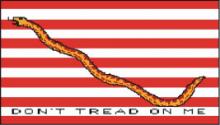|
American Flag |
One of the first flags flown by the United States Navy may have been an adaptation of the "Rebellious Stripes" created at the time of the Stamp Act Congress. It featured thirteen red and white horizontal (rather than vertical) stripes. Stretched across them was the rippling form of a rattlesnake, and the words, "DON'T TREAD ON ME" – a striking indication of the colonists' courage and fierce desire for independence. The flag known today as the Culpepper Ensign is believed to have flown aboard the Alfred, flagship of the newly commissioned Continental fleet, in January, 1776. American ships used this flag, or one of its variations, throughout the Revolutionary War. This powerful American symbol is being used again today by the United States Navy in the War on Terrorism. The rattlesnake had long been a symbol of resistance to the British in Colonial America. The phrase "Don't Tread on Me" was coined during the American Revolutionary War, a variant perhaps of the snake severed in segments labeled with the names of the colonies and the legend "Join, or Die", which had appeared first in Benjamin Franklin's Pennsylvania Gazette in 1754, as a political cartoon reflecting on the Albany Congress. Similarly, the Culpepper Flag, banner of the Culpepper (now spelled Culpeper) County, Virginia militia, consisted of a white field with a rattlesnake in a spiral coil in the center. Above the rattlesnake was the legend "The Culpepper Minute Men" and below, the motto, "Liberty or Death," as well as "Don't Tread on Me." The "Gadsden Flag" also included a rattlesnake in a spiral coil, with the legend "Don't Tread on Me," all on a yellow field. The rattlesnake (specifically, the Timber Rattlesnake) is especially significant and symbolic to the American Revolution. The rattle has thirteen layers, signifying the original Thirteen Colonies. And, the snake does not strike until provoked, a quality echoed by the phrase "Don't Tread on Me." In December 1775, Benjamin Franklin published an essay in the Pennsylvania Journal under the pseudonym "American Guesser" in which he suggested that the rattlesnake was a good symbol for the American spirit: I recollected that her eye excelled in brightness, that of any other animal, and that she has no eye-lids. She may therefore be esteemed an emblem of vigilance. She never begins an attack, nor, when once engaged, ever surrenders: She is therefore an emblem of magnanimity and true courage. As if anxious to prevent all pretensions of quarreling with her, the weapons with which nature has furnished her, she conceals in the roof of her mouth, so that, to those who are unacquainted with her, she appears to be a most defenseless animal; and even when those weapons are shown and extended for her defense, they appear weak and contemptible; but their wounds, however small, are decisive and fatal. Conscious of this, she never wounds 'till she has generously given notice, even to her enemy, and cautioned him against the danger of treading on her. Was I wrong, Sir, in thinking this a strong picture of the temper and conduct of America? |

